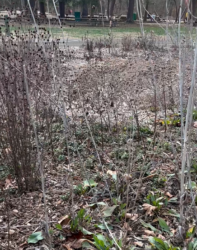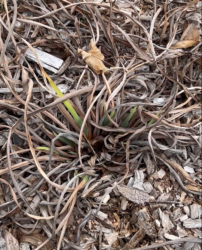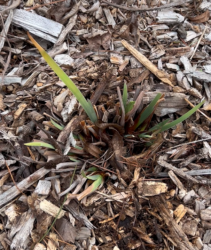By Renee Frith
 As the days begin to lengthen and a warmer breeze enters the air, many feel inspired to get outdoors. Bernheim Horticulture staff has been busy over the winter months pruning trees throughout the Arboretum. But, pruning is not just for trees! Now is a great time to start cutting back perennials. Here are some helpful tips for a successful spring flush:
As the days begin to lengthen and a warmer breeze enters the air, many feel inspired to get outdoors. Bernheim Horticulture staff has been busy over the winter months pruning trees throughout the Arboretum. But, pruning is not just for trees! Now is a great time to start cutting back perennials. Here are some helpful tips for a successful spring flush:
Why are perennial seed heads left up in the winter?
Not all perennials go dormant at the same time. Some like Helianthus sp. (sunflower group), Rudbeckia sp. /Echinacea sp. (coneflower group), and Aster sp. (daisy group) bloom well into November. Later bloom time means that seed dispersal happens in winter. Seed dispersal not only ensures new plants, it also helps feed birds and small mammals. Leaving seed heads up throughout the winter ensures optimal opportunity for dispersal. Not to mention, the brown and amber colors and the many textures of dormant perennials can be quite striking visually.
Another benefit is to our friends, the cavity-nesting wasps, stem-boring moths, and even some spiders that call the hollow stems of some perennials home in winter.

What is a good indicator of cutback time?
The stems and seed heads of perennials will fade in color over time. They will go from vibrant shades of amber and brown hues to grey. Yes, just the boring color grey. We suggest waiting until all perennials in your space have this grey appearance so that you can efficiently perform cutbacks to all at the same time.
What gets cut back?
Focus on removing only the grey stems, seed heads and foliage. Make sure anything that is green is left intact, as this is the start of the spring flush.
What are some other steps?
This time of year, we recommend removing any weeds from the planting beds, which will help reduce weed competition in spring. Once perennials have been cut back, apply a generous layer (about 2 inches) of mulch.
When having little ones help with this activity, be sure they know not to cover up the perennials. Mulch helps reduce weed competition, helps with moisture retention and is a great media for fungal activity as the mulch decays overtime.
Bernheim uses wood chips created from tree work over the Winter. When using mulch, we caution against using chemically dyed and/or cypress mulch. Natural wood chips are a more sustainable option.
So what next?
Consider your perennials ready for spring flush! Between now and spring bloom season, come out to Bernheim and enjoy connecting with our team and nature.



